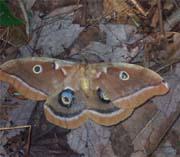

|
Butterflies, Moths and
Caterpillars Primary Reference Resources: Peterson's "A Field Guide to Eastern Butterflies" by Paul Opler and Vichai Malikul "Audubon Field Guide to the Mid-Atlantic States" by Peter Alden and Brian Cassie "Peterson's First Guide to Caterpillars" by Amy Bartlett Wright Butterflies and Moths of North America U.S.G.S. Caterpillars of Eastern Forest Tom Murray's Caterpillar Photographs Butterflies |
|
Moths
|

Polyphemus Moth (Antheraea polyphemus): The false eyes on the wings help to ward off predators. Location: Moore Run Trail, Otter Creek Wilderness, MVF. Caterpillar Photo at Great Falls National Park, MD by Ken Clark. Virginia ctenucha (Ctenucha virginica) A moth of the Arctiidae family. Lives in wet meadows.Location Dolly Sods. Photo by Elise Kreiss. |

Luna Moth (Actias luna) : Nocturnal. The adult moth (top photo) was found sleeping on the underside of a leaf on Pond Run Tr, Great North Mt, GWNF, WV. Photo by Ken Clark. In the second photo a young moth recently escaped from its cocoon clings to a tree as it waits for its wings to unfurl and dry out. Location: Prince William Forest Park, VA. Photo by D. J. Gaskin. The moth stage of this species has no mouth so cannot eat. The sole purpose of its two week life span is to pro-create. Hummingbird Moth (Hemaris thysbe): Clear wings and a long probiscus along with its ability to hover gives this guy its name. Location: Dolly Sods North, Bear Rocks Tr, MNF, WV. .
|
The infamous Gypsy Moth (Lymantria dispar) and pupae/caterpillars: Brought to N.Y. to crossbreed with silk worms. Some escaped. They are now found throughout the U.S. Capable of totally defoliating entire Oak Forests which eventually die. Location: SNP, VA. Photo by Roger Eastman. White Wave Moth (Cabera pusaria) From a distance it looks like a bird dropping - it's method of camouflage |
Leconte's Haploa (Haploa lecontei):Related to the above Lichen Moth.Location: Allegheny Tr, WV. Photo by Pat Roberts. Clymene Moth (Haploa Clymene): Cross pattern makes this moth easy to identify. Photo by Dimitri Tundra. Virginia Creeper Sphinx (Darapsa myron): This animated looking fellow eats decaying fruit. The caterpillar eats ... Virginia Creeper and Grape Leaves. Photo by Saki. |
Cecropia moth (Hyalophora cecropia): With a wing span between 5 and 6 inches this is the largest moth north of the Rio Grande! Shown here copulating. Location: Long Pond Trail, near Long Pond, Green Ridge State Forest, MD. Close-up photo by Reggie Duke. Orange (Yellow) and Black Lichen Moth (Lycomorpha pholus ): One of several varieties. The caterpillars of these species eat lichen, hence the name!
|
|
Caterpillars
|
|
Navigate |